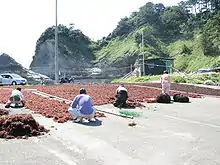Gelidium amansii
Gelidium amansii, also known as umutgasari,[1] is an economically important species of red algae commonly found and harvested in the shallow coast (3 to 10 m or 10 to 33 ft of depth below the water) of many East Asian countries including North and South Korea, China, Japan, Singapore, and northeast Taiwan.[2] G. amansii is an important food source in East Asian countries and has been shown to have medicinal effects on dieting.[3] Hence, in folklore medicine G. amansii is used to treat constipation.[4] This algae is used to make agar, whose components are the polysaccharide agarose and agaropectin, from the large amount of algin which is located in the algae's cell wall, as well it is sometimes served as part of a salad, puddings, jams, and other culinary dishes in producing regions.[5] Agar is a gelatinous substance that is commercially used as an incubation matrix for microbes and other products that require an ecologically friendly gelatinous matrix. G. amansii can be purple, red, to yellowish-red because it contains the class of pigments known as phycobiliprotein. Its branching body is cartilaginous and can grow up to a height of 8 to 30 cm or 3 to 12 in. G. amansii may have four or five opposite, compound-lobed, pinnate leaves on each branch. It is uniaxial with an apical cell and whorled cells coming from the axial towards the exterior of the algae. The pith is compacted with apical cells and the epidermis is formed by rounded whorled cells. G. amansii is being studied as a cheap biofuel.[6]
| Gelidium amansii | |
|---|---|
| Illustration of Gelidium amansii | |
 | |
| Drying Gelidium amansii to make agar in Japan | |
| Scientific classification | |
| (unranked): | Archaeplastida |
| Division: | Rhodophyta |
| Class: | Florideophyceae |
| Order: | Gelidiales |
| Family: | Gelidiaceae |
| Genus: | Gelidium |
| Species: | G. amansii |
| Binomial name | |
| Gelidium amansii | |
References
- "Umutgasari - Ark of Taste". Slow Food Foundation. Retrieved 11 April 2018.
- Chen; Tu; Wu (1 February 2004). "Growth-inhibitory effects of the red alga Gelidium amansii on cultured cells". Biological and Pharmaceutical Bulletin. 27 (2): 180–184. doi:10.1248/bpb.27.180. PMID 14758029.
- M.D. Guiry (29 December 1997). "Gelidium amansii (J.V.Lamouroux) J.V.Lamouroux". AlgaeBase. Retrieved 2 December 2016.
- 1929-, Duke, James A. (2002). Handbook of medicinal herbs. Duke, James A., 1929- (2nd ed.). Boca Raton, Florida: CRC Press. ISBN 978-0849312847. OCLC 48876592.CS1 maint: numeric names: authors list (link)
- Kang; Kang; Kim; Lima; Ko; Kim; Kim; Jeung; Choi; Jeon (18 February 2016). "Popular edible seaweed, Gelidium amansii prevents against diet-induced obesity". Food and Chemical Toxicology. 90: 181–187. doi:10.1016/j.fct.2016.02.014. PMID 26911551.
- Wi; Kim; Mahadevan; Yang; Bae (3 August 2009). "The potential value of the seaweed Ceylong moss (Gelidium amansii) as an alternative bioenergy resource". Bioresource Technology. 100 (24): 6658–60. doi:10.1016/j.biortech.2009.07.017. PMID 19647997.
External links
- Algaebase Species: Gelidium amansii (2008)
| Wikimedia Commons has media related to Gelidium amansii. |